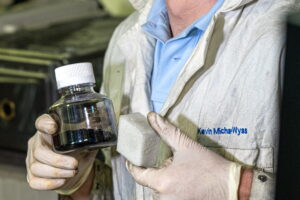
According to university researchers, the average SUV contains up to 771 pounds of plastic that could sit in a landfill for centuries but for the recycling process reported in an issue of an academic journal, Communications Engineering.
The goal of the project, led by Rice chemist James Tour and graduate student and lead author Kevin Wyss, was to reuse that graphene to make enhanced polyurethane foam for new vehicles. Tests showed the graphene-infused foam had a 34% increase in tensile strength and a 25% increase in low-frequency noise absorption. That’s with only 0.1% by weight or less of graphene.
And when that new car is old, the foam can be recycled into graphene again.
Flash Joule heating to make graphene, introduced by the Tour lab in 2020, packs mixed ground plastic and a coke additive (for conductivity) between electrodes in a tube and blasts it with high voltage. The sudden, intense heat — up to nearly 5,000 degrees Fahrenheit — vaporizes other elements and leaves behind easy-to-solubilize, turbostratic graphene.
“Ford sent us 10 pounds of mixed plastic waste from a vehicle shredding facility,” Tour said. “It was muddy and wet. We flashed it, we sent the graphene back to Ford, they put it into new foam composites and it did everything it was supposed to do.
“Then they sent us the new composites and we flashed those and turned them back into graphene,” he said. “It’s a great example of circular recycling.”
The researchers cited a study that estimates the amount of plastic used in vehicles has increased by 75% in just the past six years as a means to reduce weight and increase fuel economy.
Segregating mixed end-of-life plastic by type for recycling has been a long-term problem for the auto industry, Tour said, and it’s becoming more critical because of potential environmental regulations around end-of-life vehicles.
Much of the mixed plastic ends up being incinerated, according to co-author Deborah Mielewski, technical fellow for sustainability at Ford, who noted the U.S. shreds 10 to 15 million vehicles each year, with more than 27 million shredded globally.
“These aren’t recyclables like plastic bottles, so they can’t melt and reshape them,” Tour said. “So, when Ford researchers spotted our paper on flash Joule heating plastic into graphene, they reached out.”
Flash heating offers significant environmental benefits, as the process does not require solvents and uses a minimum of energy to produce graphene. To test whether end-of-life, mixed plastic could be transformed, the Rice lab ground the shredder “fluff” made of plastic bumpers, gaskets, carpets, mats, seating and door casings from end-of-life F-150 pickup truck to a fine powder without washing or pre-sorting the components.
The lab flashed the powder in two steps, first under low current and then high current in a heater Wyss custom designed for the experiment.
Powder heated between 10 to 16 seconds in low current produced a highly carbonized plastic accounting for about 30 percent of the initial bulk. The other 70% was outgassed or recovered as hydrocarbon-rich waxes and oils that Wyss suggested could also be recycled.
The carbonized plastic was then subjected to high-current flashing, converting 85% of it into graphene while outgassing hydrogen, oxygen, chlorine, silicon and trace metal impurities.
Ford has been using up to 60 pounds of polyurethane foam in its vehicles, with about 2 pounds of that being graphene-reinforced since 2018, according to co-author Alper Kiziltas, a technical expert at Ford research who focuses on sustainability and emerging materials. “When we got the graphene back from Rice, we incorporated it into our foam in very small quantities and saw significant improvement,” he said. “It exceeded our expectations in providing both excellent mechanical and physical properties for our applications.”
Graphene clearly has a future at Ford. The company first introduced it into a variety of other under-the-hood components and in 2020 added a graphene-reinforced engine cover. Kiziltas said the company expects to use it to reinforce hard plastics as well.